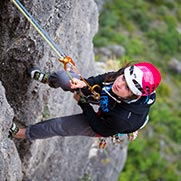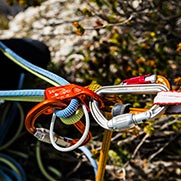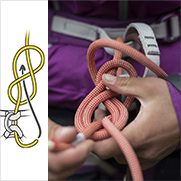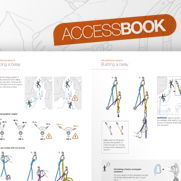Slackline with COEUR PULSE and COEUR BOLT anchors
The tension and bouncing on a slackline generates high cyclic loads that can exceed those found in climbing and other activities that the anchors were designed for.
Warnings
- Carefully read the Instructions for Use used in this technical advice before consulting the advice itself. You must have already read and understood the information in the Instructions for Use to be able to understand this supplementary information.
- Mastering these techniques requires specific training. Work with a professional to confirm your ability to perform these techniques safely and independently before attempting them unsupervised.
- We provide examples of techniques related to your activity. There may be others that we do not describe here.
The importance of proper installation for slackline anchors
Among our expansion anchors, only COEUR PULSE and COEUR BOLT 12 mm are recommended by Petzl for slacklining.
Direction of pull: place the bolts perpendicular to the load
Tests show that COEUR PULSE and COEUR BOLT do not hold up well under repeated axial loading.
Load-sharing: increasing the number of anchors is insufficient
The installation must allow each anchor to share an equal part of the load. If one anchor is loaded more than the others and fails, the shock load on the other anchors can cause them to fail as well. There are many techniques for load-sharing between anchors, the basic rule being the more acute the angle, the better the load-sharing. The more anchors there are, the more complex the installation.
WARNING: to effectively share the load between the anchors, the focal point must be mobile OR the direction of pull perfectly defined and taken into account during installation.
Insufficient strength of PULSE anchors and caving anchors
The maximum strength of PULSE and caving anchors, tested in high-quality concrete during certification, might seem sufficient for slacklining if the direction of pull is perfectly oriented. However, the risk of a pull in the wrong direction is significant; therefore Petzl recommends that these anchors not be used for slacklining or for any other similar activity.
Strength testing of anchors
An anchor is designed to support a static load and/or an occasional dynamic load (fall). Cyclic dynamic loading is inherent in slacklining.
Anchor fatigue resistance
A characteristic of slacklining is that the highly tensioned webbing transmits cyclic loads to the anchors (vibration, bouncing, falls). The load sustained by the anchor is not only the initial tension in the webbing: the use of the line increases this tension.
The frequency and the force applied to the anchors depends on many parameters: initial tension, line length, type of displacement, number of falls, number of anchors and efficacy of load-sharing...
Laboratory test of anchor fatigue resistance:
A load value of 5 kN was chosen for the tests; this corresponds to a 10 to 12 kN load on the slackline which would be roughly shared between three anchors.
The test consists of a succession of loads at the chosen value, then unloading, at a frequency of 1 Hz. The number of cycles before break is measured.
Static strength of COEUR PULSE and COEUR BOLT anchors
The maximum strength of COEUR PULSE and COEUR BOLT anchors, tested in high quality concrete during certification, is hypothetically sufficient for slackline use.
Note 1: any incorrect installation or installation in poor-quality rock or concrete can reduce anchor strength; see the Instructions for Use for COEUR PULSE and COEUR BOLT.
Note 2: the maximum strength value does not take into account any non-destructive deformation of the anchors, which can occur at significantly lower values.







